Dear Zazie,
Here is today’s Lovers’ Chronicle from Mac Tag.
Rhett
The Lovers’ Chronicle
here i draw forth my journal, turn to this page and with pen, after thinkin’ a moment, write these words
it is my privilege to have you lookin’ over my shoulder, to have you here to listen
i was late comin’ to realize my purpose, what i want
with gratitude held high
i thank you
© 2021 mac tag/cowboycoleridge all rights reserved
© copyright 2020 mac tag/cowboy coleridge all rights reserved
inspiration
to not hold
feelin’s too close
then everything
else fades
and all
that went before
is as if
it had never been
only ever been
worth a damn
when in thrall
as with you
The Poem of the Day is a translated amalgam of verses from de Quental’s sonnets (see below). A sonnet sampler on dreams! A favorite topic here at TLC.
I Dreamed I Dream
I dreamed (dreams are not always vain, it seems)
I had been carried off by winds that moan
Across the starry space; the stellar zone
Where dawn eternally has smiles, and beams.
I dream I’m a knight who ventures forth
Through deserts, hot days, and pitch-black nights.
A defender of love, with all my might
I seek the enchanted palace of Fortune!
Fly on misfortune’s wing as black as night,
You thought of love, your shadow of an hour
That I embraced delirious in my tower.
Fly as a windswept cloud, and pass from sight.
Let hope be but a dream, or even less;
Although it always comes with pain and dole,
Deceiving all except misfortune’s scope
Vision of my dreams! If you are the truth,
Reveal yourself to me in heaven at least!
The Song of the Day is “I Dreamed I Dream” by Sonic Youth.
| Lucrezia Borgia | |
|---|---|
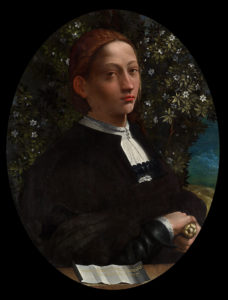 The only confirmed Lucrezia portrait painted from life (attributed to Dosso Dossi, c. 1519, National Gallery of Victoria) |
|
Today is the birthday of Lucrezia Borgia (Subiaco 18 April 1480 – 24 June 1519 Ferrara); daughter of Pope Alexander VI and Vannozza dei Cattanei. Her brothers included Cesare Borgia, Giovanni Borgia, and Gioffre Borgia.
Her family arranged several marriages for her that advanced their own political position including Giovanni Sforza (Lord of Pesaro), Alfonso of Aragon (Duke of Bisceglie), and Alfonso I d’Este (Duke of Ferrara). Tradition has it that Alfonso of Aragon was an illegitimate son of the King of Naples and that her brother Cesare may have had him murdered after his political value waned.
Rumors about her and her family cast Lucrezia as a femme fatale, a role in which she has been portrayed in many artworks, novels and films.
First marriage: Giovanni Sforza

On 26 February 1491, a matrimonial arrangement was drawn up between Lucrezia and the Lord of Val D’Ayora in the kingdom of Valencia, Don Cherubino Joan de Centelles, which was annulled less than two months later in favour of a new contract engaging Lucrezia to Don Gaspare Aversa, count of Procida. When Rodrigo became Pope Alexander VI, he sought to be allied with powerful princely families and founding dynasties of Italy. As such, he called off Lucrezia’s previous engagements and arranged for her to marry Giovanni Sforza, a member of the House of Sforza who was Lord of Pesaro and titled Count of Catignola. Giovanni was an illegitimate son of Costanzo I Sforza and a Sforza of the second rank. He married Lucrezia on 12 June 1493 in Rome.
Before long, the Borgia family no longer needed the Sforzas, and the presence of Giovanni Sforza in the papal court was superfluous. The Pope needed new, more advantageous political alliances, so he may have covertly ordered the execution of Giovanni: the generally accepted version is that Lucrezia was informed of this by her brother Cesare, and she warned her husband, who fled Rome.
Alexander asked Giovanni’s uncle, Cardinal Ascanio Sforza, to persuade Giovanni to agree to an annulment of the marriage. Giovanni refused and accused Lucrezia of paternal incest. The pope asserted that his daughter’s marriage had not been consummated and was thus invalid. Giovanni was offered her dowry in return for his cooperation. The Sforza family threatened to withdraw their protection should he refuse. Giovanni finally signed confessions of impotence and documents of annulment before witnesses.
There has been speculation that during the prolonged process of the annulment, Lucrezia consummated a relationship with someone, perhaps Alexander’s chamberlain Pedro Calderon, also named Perotto. Families hostile to the Borgias would later accuse her of being pregnant at the time her marriage was annulled for non-consummation. She is known to have retired to the convent of San Sisto in June 1497 to await the outcome of the annulment proceedings, which were finalized in December of the same year. The bodies of Pedro Calderon, and a maid, Pantasilea, were found in the Tiber in February 1498. In March 1498, the Ferrarese ambassador claimed that Lucrezia had given birth, but this was denied by other sources. A child was born, however, in the Borgia household the year before Lucrezia’s marriage to Alfonso of Aragon. He was named Giovanni but is known to historians as the “Infans Romanus“.
In 1501, two papal bulls were issued concerning the child, Giovanni Borgia. In the first, he was recognized as Cesare’s child from an affair before his marriage. The second, contradictory, bull recognized him as the son of Pope Alexander VI. Lucrezia’s name is not mentioned in either, and rumors that she was his mother have never been proven. The second bull was kept secret for many years, and Giovanni was assumed to be Cesare’s son. This is supported by the fact that in 1502 he became Duke of Camerino, one of Cesare’s recent conquests, hence the natural inheritance of the Duke of Romagna’s oldest son. Giovanni went to stay with Lucrezia in Ferrara after Alexander’s death, where he was accepted as her half-brother.
Second marriage: Alfonso d’Aragon (Duke of Bisceglie)

Following her annulment from Sforza, Lucrezia was married to the Neapolitan Alfonso of Aragon, the half-brother of Sancha of Aragon who was the wife of Lucrezia’s brother Gioffre Borgia. The marriage was a short one.
They were married in 1498; Lucrezia—not her husband—was appointed governor of Spoleto in 1499; Alfonso fled Rome shortly afterwards but returned at Lucrezia’s request, only to be murdered in 1500.
It was rumored that Lucrezia’s brother Cesare was responsible for Alfonso’s death, as he had recently allied himself (through marriage) with France against Naples. Lucrezia and Alfonso had one child, Rodrigo of Aragon, who was born in 1499 and predeceased his mother in August 1512 at the age of 12.
Third marriage: Alfonso d’Este (Duke of Ferrara)
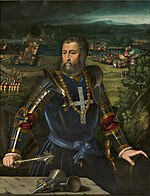
After the death of Lucrezia’s second husband, her father, Pope Alexander VI, arranged a third marriage. She married Alfonso I d’Este, Duke of Ferrara, in early 1502 in Ferrara. She had eight children during this marriage and was considered a respectable and accomplished Renaissance duchess, effectively rising above her previous reputation and surviving the fall of the Borgias following her father’s death.
Neither partner was faithful: beginning in 1503, Lucrezia enjoyed a long relationship with her brother-in-law, Francesco II Gonzaga, Marquess of Mantua. Francesco’s wife was the cultured intellectual Isabella d’Este, the sister of Alfonso, to whom Lucrezia had made overtures of friendship to no avail. The affair between Francesco and Lucrezia was passionate, more sexual than sentimental as can be attested in the fevered love letters the pair wrote one another.
Lucrezia also had a love affair with the poet Pietro Bembo during her third marriage. Their love letters were deemed “The prettiest love letters in the world” by the Romantic poet Lord Byron when he saw them in the Ambrosian Library of Milan on 15 October 1816. On the same occasion Byron claimed to have stolen a lock of Lucrezia’s hair – “the prettiest and fairest imaginable”.
Lucrezia met the famed French soldier, the Chevalier Bayard while the latter was co-commanding the French allied garrison of Ferrara in 1510. According to his biographer, the Chevalier became a great admirer of Lucrezia’s, considering her a “pearl on this Earth”.
After a long history of complicated pregnancies and miscarriages, on 14 June 1519 Lucrezia gave birth to her tenth child, named Isabella Maria in honour of Alfonso’s sister Isabella d’Este. The child was sickly and – fearing she would die unbaptised – Alfonso ordered her to be baptised straightaway with Eleonora della Mirandola and Count Alexandro Serafino as godparents.
Lucrezia had become very weak during the pregnancy and fell seriously ill after the birth. After seeming to recover for two days, she worsened again and died on 24 June the same year. She was buried in the convent of Corpus Domini.
She is described as having heavy blonde hair that fell past her knees, a beautiful complexion, hazel eyes that changed color, a full, high bosom, and a natural grace that made her appear to “walk on air”. These physical attributes were highly appreciated in Italy during that period. Another description said, “her mouth is rather large, the teeth brilliantly white, her neck is slender and fair, and the bust is admirably proportioned.”
One painting, Portrait of a Youth by Dosso Dossi at the National Gallery of Victoria, was identified as a portrait of Lucrezia in November 2008. This painting may be the only surviving formal portrait of Lucrezia Borgia; however, doubts have been cast on that attribution. Several other paintings, such as Veneto’s fanciful portrait, have also been said to depict her, but none have been accepted by scholars at present.
Several rumours have persisted throughout the years, primarily speculating as to the nature of the extravagant parties thrown by the Borgia family. Many of these concern allegations of incest, poisoning, and murder on her part; however, no historical basis for these rumours has ever been brought forward beyond allegations made by rival parties. It is rumoured that Lucrezia was in possession of a hollow ring that she used frequently to poison drinks.

Today is the baptismal day of Thomas Middleton (London 1580 – July 1627 Southwark); English Jacobean playwright and poet. Middleton stands with John Fletcher and Ben Jonson among the most successful and prolific playwrights who wrote their best plays during the Jacobean period. He was one of the few Renaissance dramatists to achieve equal success in comedy and tragedy.
Let the air strike our tune,
Whilst we show reverence to yond peeping moon.
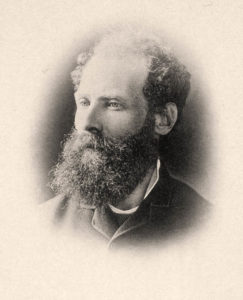 Today is the birthday of poet, philosopher and writer Antero de Quental (Ponta Delgada on the island of São Miguel, in the Azores18 April 1842 – 11 September 1891 Ponta Delgada). His works became a milestone in the Portuguese language alongside those of Camões, Bocage, and Fernando Pessoa.
Today is the birthday of poet, philosopher and writer Antero de Quental (Ponta Delgada on the island of São Miguel, in the Azores18 April 1842 – 11 September 1891 Ponta Delgada). His works became a milestone in the Portuguese language alongside those of Camões, Bocage, and Fernando Pessoa.
Throughout his life, de Quental oscillated between pessimism and depression; afflicted with what might have been bipolar disorder, at the time of his last trip to Lisbon, he was in a state of steady depression, compounded by spinal disease. After a month in Lisbon, he returned once again to Ponta Delgada around June 1891. On September 11 that year, at about 8:00 PM, he shot himself in the stomach twice, while seated on a bench in a local garden park. He died approximately an hour later. De todas as coisas, o pior é ter nascido (“Of all things, the worst is having been born,”) he wrote in a poem.
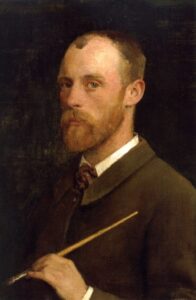 Today is the birthday of George Clausen (London 18 April 1852 – 22 November 1944 Cold Ash, West Berkshire, England); artist working in oil and watercolour, etching, mezzotint, drypoint and occasionally lithographs.
Today is the birthday of George Clausen (London 18 April 1852 – 22 November 1944 Cold Ash, West Berkshire, England); artist working in oil and watercolour, etching, mezzotint, drypoint and occasionally lithographs.
Clausen became one of the foremost modern painters of landscape and of peasant life, influenced to a certain extent by the Impressionists, with whom he shared the view that light is the real subject of landscape art. His pictures excel in rendering the appearance of things under flecking outdoor sunlight, or in the shady shelter of a barn or stable. His Girl at the Gate was acquired by the Chantrey Trustees and is now at the Tate Gallery. The Yale Center for British Art holds Clausen’s Schoolgirls (1880), an urban scene, which it featured in its exhibit called “Britain in the World: 1860-Now.”
Clausen was an official war artist during World War I. During the war his daughter’s fiancé was killed; this event may have inspired his painting, Youth Mourning which shows a distressed young woman mourning in a desolate landscape.
Gallery
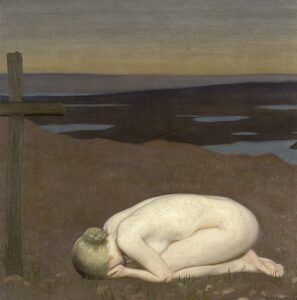
Youth mourning
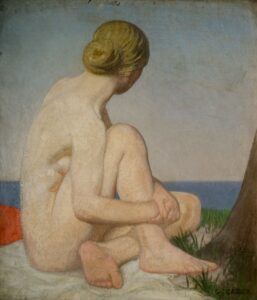
The watcher
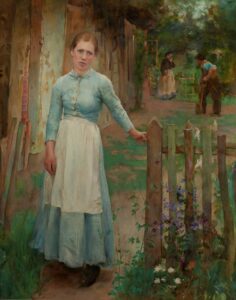
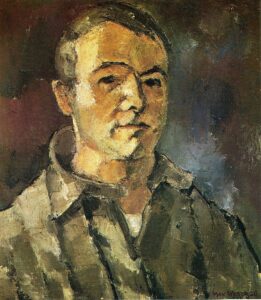 And today is the birthday of Max Weber (Białystok, Poland; April 18, 1881 – October 4, 1961); painter and one of the first American Cubist painters who, in later life, turned to more figurative Jewish themes in his art. He is best known today for Chinese Restaurant (1915), in the collection of the Whitney Museum of American Art, “the finest canvas of his Cubist phase,” in the words of art historian Avis Berman.
And today is the birthday of Max Weber (Białystok, Poland; April 18, 1881 – October 4, 1961); painter and one of the first American Cubist painters who, in later life, turned to more figurative Jewish themes in his art. He is best known today for Chinese Restaurant (1915), in the collection of the Whitney Museum of American Art, “the finest canvas of his Cubist phase,” in the words of art historian Avis Berman.
Weber emigrated to the United States and settled in Brooklyn with his Orthodox Jewish parents at the age of ten. He studied art at the Pratt Institute in Brooklyn under Arthur Wesley Dow. Dow was a fortunate early influence on Weber as he was an “enlightened and vital teacher” in a time of conservative art instruction, a man who was interested in new approaches to creating art. Dow had met Paul Gauguin in Pont-Aven, was a devoted student of Japanese art, and defended the advanced modernist painting and sculpture he saw at the Armory Show in New York in 1913.
In 1905, after teaching in Virginia and Minnesota, Weber had saved enough money to travel to Europe, where he studied at the Académie Julian in Paris and acquainted himself with the work of such modernists as Henri Rousseau (who became a good friend), Henri Matisse, Pablo Picasso, and other members of the School of Paris. His friends among fellow Americans included some equally adventurous young painters, such as Abraham Walkowitz, H. Lyman Sayen, and Patrick Henry Bruce. Avant-garde France in the years immediately before World War I was fertile and welcoming territory for Weber, then in his early twenties. He arrived in Paris in time to see a major Cézanne exhibition, meet the poet Guillaume Apollinaire, frequent Gertrude Stein’s salon, and enroll in classes in Matisse’s private “Academie.” Rousseau gave him some of his works; others, Weber purchased. He was responsible for Rousseau’s first exhibition in the United States.
Gallery
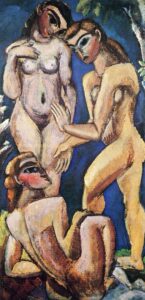
The three graces
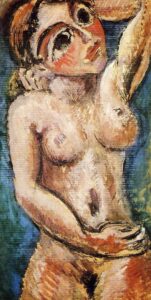
Nude
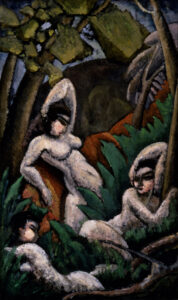
Summer
Mac Tag

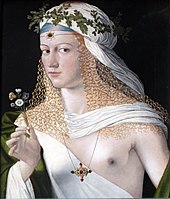

No Comments on "The Lovers’ Chronicle 18 April – inspire – birth of Lucrezia Borgia – verse by Thomas Middleton – verse by Antero de Quental – art by George Clausen & Max Weber"